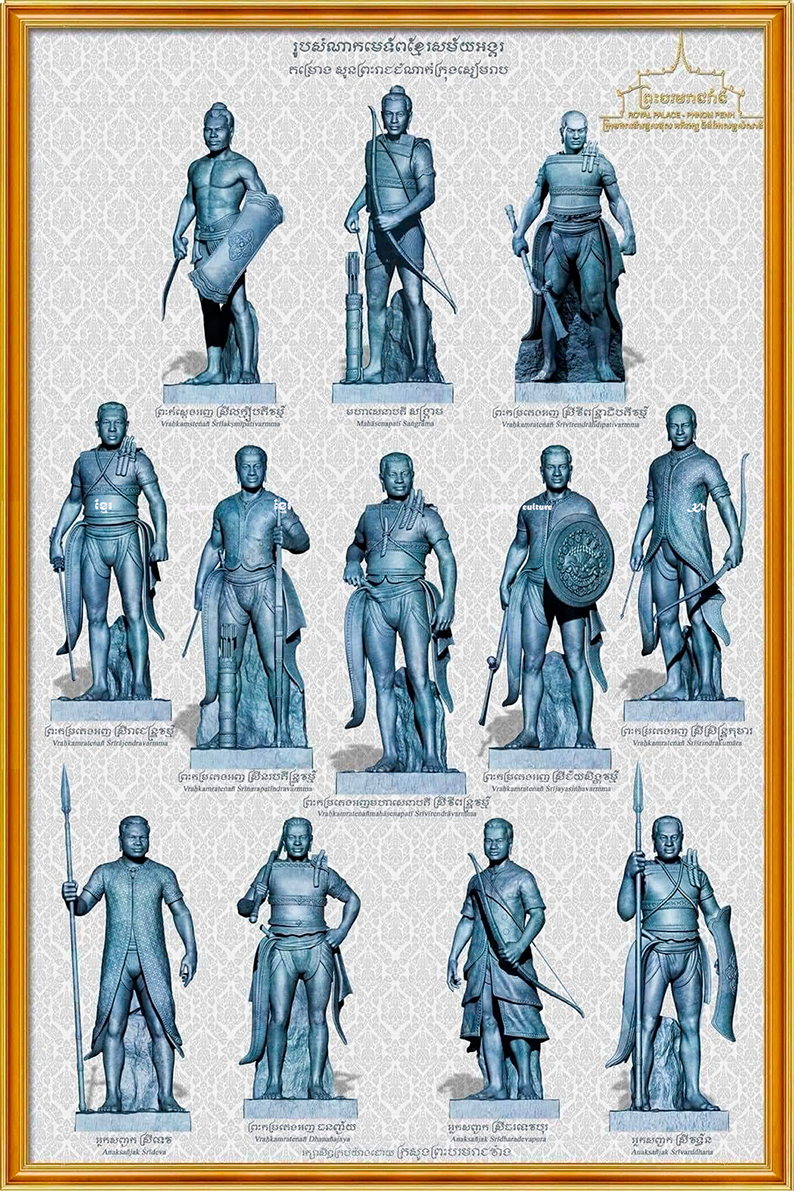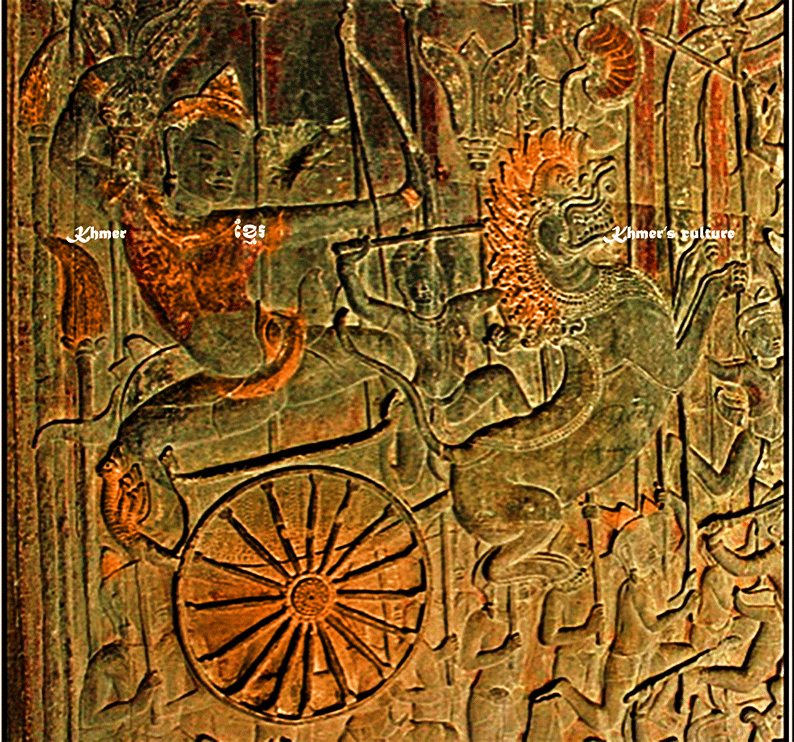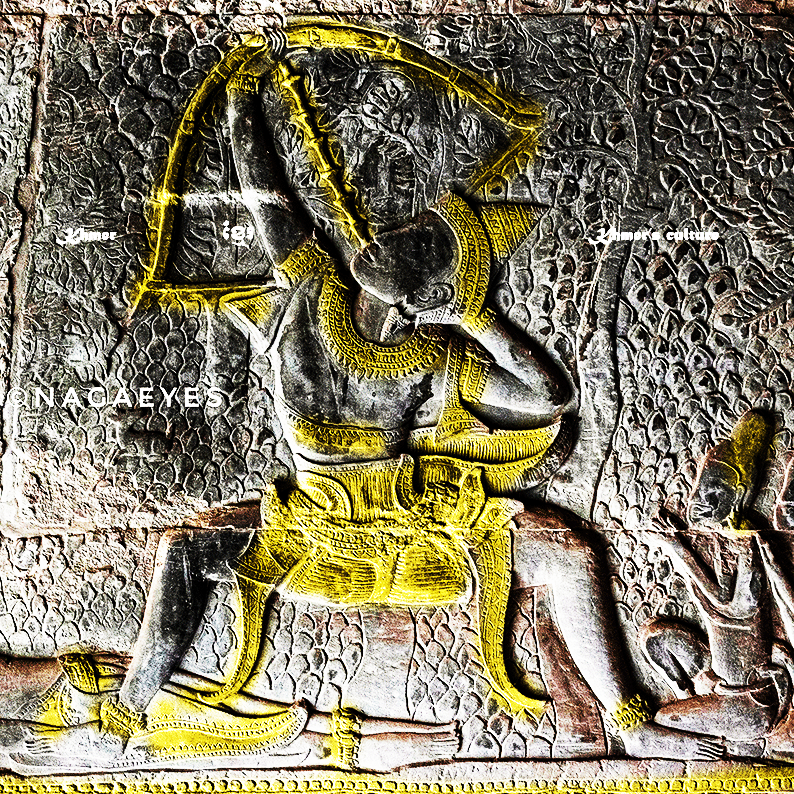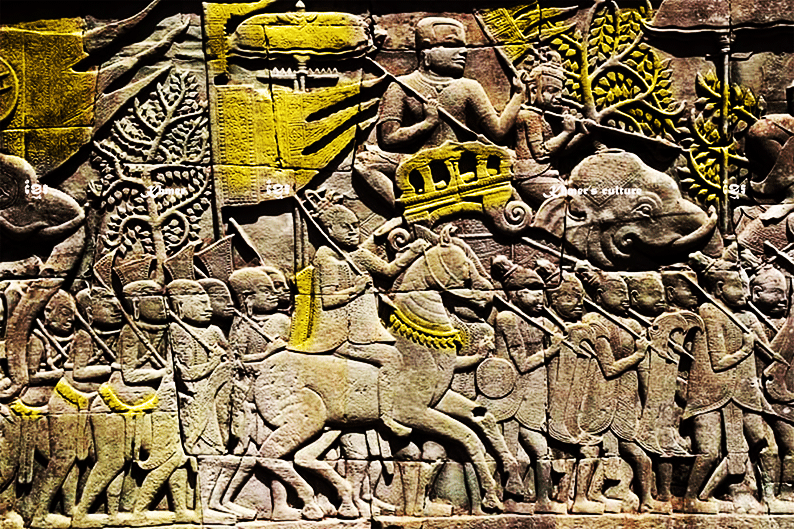| Ce page est didié à la mémoire de tout puissant armée khmère |
| The powerful Khmer's army in action engraved on the walls of Khmer temples 1-2-3-4-5-6-7- Chinese warriors, tai japanese manchu at Angkor, Bayon bas-relief - tai qing mingmang, vn mingmang macu warriors, Tang and the stolen Khmer's artefact at Singapore's museum, |
Un Empire puissant qui domine toute région SEA plus de mille ans comme ce de l'Empire Khmer devrait posséder une armée puissante presque invincible. L'armée de l'Empire khmer depuis époque pré-Angkor à Angkor reste très mal documenté à part les prestiges sur les temples mal exploités par les académiciens et par les Khmers eux-mêmes. Pour la période pré-Angkor, on peut notamment observer les quelques images impressionnantes laissés sur les murs de temple Sambo-Prei-Gupta (Sambo-preikub) L’Uniform de l'armée khmer de cette période ressemble étrangement à ce de l'armée perse, l’armée de Mésopotamie et pas seulement. L'art, le coiffage, le porte de tête de soldats, des rois, des divinités ainsi que leurs habiles, etc se ressemblent à l'empire perse, l’empire assyrien et égyptien. Cet héritage perdure jusqu'à au moins la fin de période Angkor (14th) mais prend une forme différente. Pour ce qui est de l’époque Angkor, on a de nombreux sculptes gravés sur les murs des temples khmers notamment à Angkor, Bayon, Banteay Srei, Banteay Chhmars. Sur les murs d’angkor l’art de guerre (Kun khmer/art martial khmer) de l’armée khmère se dissimule à travers les batailles mythiques de Kurukshetra et de Lanka. La démonstration de la puissance de l’armée khmère à travers cet art est extraordinaire et somptueuse. Les rois, les militaires se mélangent avec les dieux et les déesses. Les différentes techniques de combat de Kun Khmer et le Lbokator sont démontrés à traverse les batailles des Dieux et des démons de Védisme, de mahabharata et de ramayana. Le tout puissant armée khmer a résisté à l’invasion musulmane et aux nombreuses tentatives d’invasion et soumission mongole. Cela permet de préserver toute la région sous domination de l’empire de l’islamisation n'a pas pu résister à la tai-Chine après déchut de Mongole. Cependant, la confrontation directe et indirecte avec l’armée mongole tout puissant a définitivement affaibli l’empire khmer. Les différentes potions de peuples ou groupes dignitaires jusqu’ici sous domination de l’Empire khmer se détachaient de l’Empire créant des nouveaux petits royaumes avec l’assistance de leurs nouveaux maitres Mongole, puis Son, Ming et Qing. Dès 1232, çri Indrapatîndrâditya ou Pha Moung, père de Ramakamhaeng qui a épousé la princesse d’Angkor, Sikharamahadevi, s’allié avec le Mongol et a détaché le Sukuthai/Sokhotei de l’empire khmer puis l’attaqués massivement. Les Chams avec l’assistance de l’armée mongoles puis celle des chinois et yuons réclament leur détachement du Cambodge. Affaibli, attaqués de tout part par les mongole, les chinois, les tais, les chams-chin-yuon, l’Empire khmer s’inclinait. En 1350, les chinois et d’autre ethnies sino-tai de Ayuthaya se révoltaient contre l’Empire khmer et réclamait la création de nouveau royaume tai/siam. En 1352 et 1441, les tais/siam ont attaqués, envahis et pillés la cité sacrée des Khmers, l’Angkor. Des militaires et dignitaires sont massacrés, les sages, les maitres et les danseurs ont été déportés à Ayuthaya. Mais malgré tout, le Cambodge a pu préserver la majorité de son territoire de Kampuchea krom jusqu’à port de Nokoreachsei (Nokor reachsima/korat en tai) au moins jusqu’à fin 19th siècle comme le montre cette carte géographie. C’est à la fin de 19th, c’est-à-dire, à la suite de l’invasion du Cambodge par l’armée sino-tai de qing que le Cambodge se vide de son sang par le génocide perpétué par les tais et les qing côté ouest et les yuon and ming de côté est. Les Burmans et les Laos ont subi de même sort ainsi que les Khmers vivant dans le territoire fraichement conquis par les qing et les tai/siam/thai. Cela pourrait se termine mal pour le Cambodge si sans intervention aventuriers des occidentaux dans la région. Depuis ce jour, le Cambodge n’a jamais pu se lever de sa cendre et les chinois, les tai, les yuons, n’ont pas encore payé leurs notes souillés de sang khmer. Chan For the pre-Angkor period, we can notably observe the few impressive images left on the walls of the Sambo-Prei-Gupta temple (Sambo-preikub). We can remark the uniform of the Khmer army of that period strangely resembles to that of the Persian army and the Mesopotamia army like Assyria, Kouchana and not only. The art, hairstyle, the helmets of the warriors, the kings, the deities as well as their uniform and clothes, etc. are similar to those of Persian empire, Assyrian and Egyptian’s empire. This heritage lasts until at least the end of the Angkor period (14th) but takes a different form. As for the Angkor period, there are numerous sculptures engraved on the walls of Khmer temples, notably at Angkor, Bayon, Banteay Srei, Banteay Chhmars. On the walls of Angkor, Khmer’s martial art/Kun Khmer and Angkorian warriors dissimulated in the mythical battles of Kurukshetra and Lanka and other mystiques battle. The demonstration of the powerful Khmer army through this art is so extraordinary and sumptuous. The different combat techniques of Kun Khmer (Khmer's martial art) and the Lbokator as well Khmer’s warriors and Emperors mixed with the gods and goddesses of Vedism, Mahabharata and Ramayana in purely Khmer concept. The powerful Khmer army resisted the Muslim invasion the numerous attempts of Mongol invasion and submission and had placed under its protection the Chinese soldiers and royalties who had fled Mongol's massacre. These Chinese soldiers and royalties of Son dynasty who fled china and installed under the protection of the Khmer Empire had learned the different skills of the Khmer Empire, in particularly the combat techniques of the Khmer Empire. This allowed Son and Ming to organize the counter-offensive against the Mongols, chassed the Mongol out of China and became the only powerful nation in the region until today. After historical records, at the end of the 13th century, there were more than 2 hundred communities of Son dynasty who had fled China to install in Cambodia and these not yet included thousands and thousands other militaries and ordinary Chinese who fled war and massacred to be protected by Khmer. Though, we can remark on the wall of Bayon, the Chinese legion parading with Khmer’s warriors alongside with other foreign legion groups. Some were even decorated with the title Kam'rar Tang Anh, the highest rank in the Khmer army of that period. Though, we can modestly attribute the conception of organized and hierarchical foreign legions to the Khmer Empire. Moreover, Chinese nobles, royalties, war refugees ect do not only serve in the military ranks, they are also artisans, traders, workers and cookers. However, the direct and indirect confrontation with the powerful Mongol army definitively weakened the Khmer empire. The different potions of ethnics, vasal kingdoms and dignitary groups until now under the domination of the Khmer Empire broke away from the Empire and founded new small kingdoms with the assistance of their new masters Mongol, then Son, Ming and Qing. From 1232, çri Indrapatîndrâditya or Pha Moung, father of Ramakamhaeng who married the Khmer’s princess, Sikharamahadevi, allied himself with the Mongol and detached Sukuthai/Sokhotei from the Khmer empire then massively attacked. Zhou Daguan (ou Tcheou Ta-Kouan, Chou Ta-kuan), sino-mongole ambassy delegation who visited Angkor at the end of 13th has briefly talk about it all by a remarkable desire to hide Chinese and Mongol hand in that crime. Merely at the same moment, the Chams, with the assistance of the Mongolian army and then that of the Chinese and Yuons, detachment from Khmer’s empire. Weakened, attacked from all sides by the Mongols, the Chinese, the Tais, the Chams-chin-yuon, the Khmer Empire decline. In 1350, the Chinese and other Sino-Tai ethnic groups of Ayuthaya revolted against the Khmer Empire and founded a new nation, the Tai/Siam kingdom. In 1352 and 1441, the tais/siam attacked, invaded and pillaged the sacred city of the Khmers, Angkor. Khmer people, warriors, civils and dignitaries were massacred, wise men, masters and dancers were deported to Ayuthaya. But in despite of all these torments, Cambodia was able to preserve the majority of its territory from Kampuchea krom to the port of Nokoreachsei (Nokor reachsima/korat en tai) at least until the end of the 19th century as this geographic map shows. It was at the end of the 19th century, that is to say, following the invasion of Cambodia by the Sino-Tai army of Qing that Cambodia bled to death through the genocide perpetuated by, the sino-tais(qing) from the west side and the yuon and ming on the east side. The Burmans and Laos were not less suffered by the this mass graves massacre as well as the Khmers living in the territory freshly conquered by the Qing and the Tai/Siam/Thai. This could be an end for Cambodia without intervention of the westerners in the region. Since that day, Cambodia has never been able to rise from its ashes and the Chinese, the tai, the yuons, have not yet paid their bills stained with Khmer blood. Chan |
 |
| L'art de Sambo-preigupta (Sambo-preikuk) représentant armée khmère du pré-Angkor (certain photos représentent l'armée assyrienne) |
 |
 |
 |
 |
 |
 |
 |
Update Décembre 2023 |
| បណ្ណាល័យព្រលឹងខ្មែរ- 7 | 6 | 5 | 4 | 3 | 2 | 1 | ~ *~ 1 | 2 | 3 | 4 | 5 | 6 | 7 - បណ្ណាល័យព្រលឹងខ្មែរ |